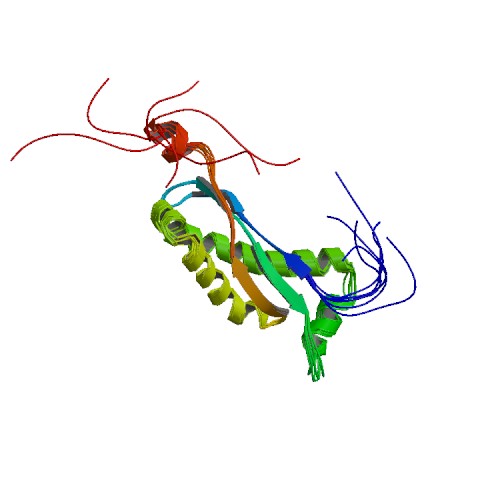FLOT2
| Flotillin 2 | |||||||||||||
|---|---|---|---|---|---|---|---|---|---|---|---|---|---|
 PDB rendering based on 1win. | |||||||||||||
| |||||||||||||
| Identifiers | |||||||||||||
| Symbols | FLOT2 ; ECS-1; ECS1; ESA; ESA1; M17S1 | ||||||||||||
| External IDs | Template:OMIM5 Template:MGI HomoloGene: 3293 | ||||||||||||
| |||||||||||||
| RNA expression pattern | |||||||||||||
 | |||||||||||||
 | |||||||||||||
| More reference expression data | |||||||||||||
| Orthologs | |||||||||||||
| Template:GNF Ortholog box | |||||||||||||
| Species | Human | Mouse | |||||||||||
| Entrez | n/a | n/a | |||||||||||
| Ensembl | n/a | n/a | |||||||||||
| UniProt | n/a | n/a | |||||||||||
| RefSeq (mRNA) | n/a | n/a | |||||||||||
| RefSeq (protein) | n/a | n/a | |||||||||||
| Location (UCSC) | n/a | n/a | |||||||||||
| PubMed search | n/a | n/a | |||||||||||
Flotillin 2, also known as FLOT2, is a human gene.[1]
Caveolae are small domains on the inner cell membrane involved in vesicular trafficking and signal transduction. This gene encodes a caveolae-associated, integral membrane protein, which is thought to function in neuronal signaling.[1]
References
Further reading
- Schroeder WT, Siciliano MJ, Stewart-Galetka SL, Duvic M (1992). "The human gene for an epidermal surface antigen (M17S1) is located at 17q11-12". Genomics. 11 (2): 481–2. PMID 1769667.
- Schroeder WT, Stewart-Galetka S, Mandavilli S; et al. (1994). "Cloning and characterization of a novel epidermal cell surface antigen (ESA)". J. Biol. Chem. 269 (31): 19983–91. PMID 8051082.
- Maruyama K, Sugano S (1994). "Oligo-capping: a simple method to replace the cap structure of eukaryotic mRNAs with oligoribonucleotides". Gene. 138 (1–2): 171–4. PMID 8125298.
- Suzuki Y, Yoshitomo-Nakagawa K, Maruyama K; et al. (1997). "Construction and characterization of a full length-enriched and a 5'-end-enriched cDNA library". Gene. 200 (1–2): 149–56. PMID 9373149.
- Volonte D, Galbiati F, Li S; et al. (1999). "Flotillins/cavatellins are differentially expressed in cells and tissues and form a hetero-oligomeric complex with caveolins in vivo. Characterization and epitope-mapping of a novel flotillin-1 monoclonal antibody probe". J. Biol. Chem. 274 (18): 12702–9. PMID 10212252.
- Hazarika P, Dham N, Patel P; et al. (1999). "Flotillin 2 is distinct from epidermal surface antigen (ESA) and is associated with filopodia formation". J. Cell. Biochem. 75 (1): 147–59. PMID 10462713.
- Salzer U, Prohaska R (2001). "Stomatin, flotillin-1, and flotillin-2 are major integral proteins of erythrocyte lipid rafts". Blood. 97 (4): 1141–3. PMID 11159550.
- Solomon S, Masilamani M, Rajendran L; et al. (2002). "The lipid raft microdomain-associated protein reggie-1/flotillin-2 is expressed in human B cells and localized at the plasma membrane and centrosome in PBMCs". Immunobiology. 205 (1): 108–19. PMID 11999340.
- Wistow G, Bernstein SL, Wyatt MK; et al. (2002). "Expressed sequence tag analysis of human RPE/choroid for the NEIBank Project: over 6000 non-redundant transcripts, novel genes and splice variants". Mol. Vis. 8: 205–20. PMID 12107410.
- Strausberg RL, Feingold EA, Grouse LH; et al. (2003). "Generation and initial analysis of more than 15,000 full-length human and mouse cDNA sequences". Proc. Natl. Acad. Sci. U.S.A. 99 (26): 16899–903. doi:10.1073/pnas.242603899. PMID 12477932.
- Shin BK, Wang H, Yim AM; et al. (2003). "Global profiling of the cell surface proteome of cancer cells uncovers an abundance of proteins with chaperone function". J. Biol. Chem. 278 (9): 7607–16. doi:10.1074/jbc.M210455200. PMID 12493773.
- Lehner B, Semple JI, Brown SE; et al. (2004). "Analysis of a high-throughput yeast two-hybrid system and its use to predict the function of intracellular proteins encoded within the human MHC class III region". Genomics. 83 (1): 153–67. PMID 14667819.
- Gerhard DS, Wagner L, Feingold EA; et al. (2004). "The status, quality, and expansion of the NIH full-length cDNA project: the Mammalian Gene Collection (MGC)". Genome Res. 14 (10B): 2121–7. doi:10.1101/gr.2596504. PMID 15489334.
- Hazarika P, McCarty MF, Prieto VG; et al. (2004). "Up-regulation of Flotillin-2 is associated with melanoma progression and modulates expression of the thrombin receptor protease activated receptor 1". Cancer Res. 64 (20): 7361–9. doi:10.1158/0008-5472.CAN-04-0823. PMID 15492257.
- Rual JF, Venkatesan K, Hao T; et al. (2005). "Towards a proteome-scale map of the human protein-protein interaction network". Nature. 437 (7062): 1173–8. doi:10.1038/nature04209. PMID 16189514.
- Bracho C, Dunia I, Romano M; et al. (2006). "Caveolins and flotillin-2 are present in the blood stages of Plasmodium vivax". Parasitol. Res. 99 (2): 153–9. doi:10.1007/s00436-006-0139-6. PMID 16521037.
- Doherty SD, Prieto VG, George S; et al. (2007). "High flotillin-2 expression is associated with lymph node metastasis and Breslow depth in melanoma". Melanoma Res. 16 (5): 461–3. doi:10.1097/01.cmr.0000222592.75858.20. PMID 17013097.
- Jiang M, Ding Y, Su Y; et al. (2007). "Arginase-flotillin interaction brings arginase to red blood cell membrane". FEBS Lett. 580 (28–29): 6561–4. doi:10.1016/j.febslet.2006.11.003. PMID 17113085.
- Sugawara Y, Nishii H, Takahashi T; et al. (2007). "The lipid raft proteins flotillins/reggies interact with Galphaq and are involved in Gq-mediated p38 mitogen-activated protein kinase activation through tyrosine kinase". Cell. Signal. 19 (6): 1301–8. doi:10.1016/j.cellsig.2007.01.012. PMID 17307333.
- Langhorst MF, Solis GP, Hannbeck S; et al. (2007). "Linking membrane microdomains to the cytoskeleton: regulation of the lateral mobility of reggie-1/flotillin-2 by interaction with actin". FEBS Lett. 581 (24): 4697–703. doi:10.1016/j.febslet.2007.08.074. PMID 17854803.
| This protein-related article is a stub. You can help Wikipedia by expanding it. |